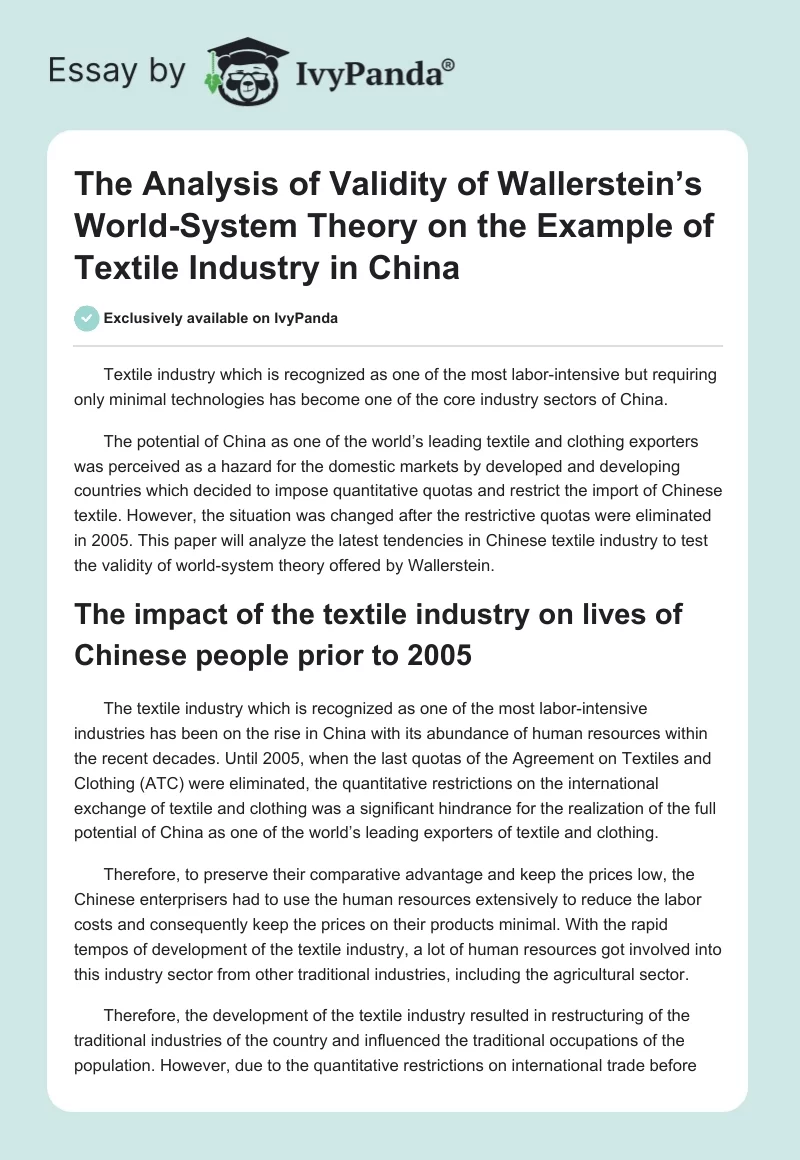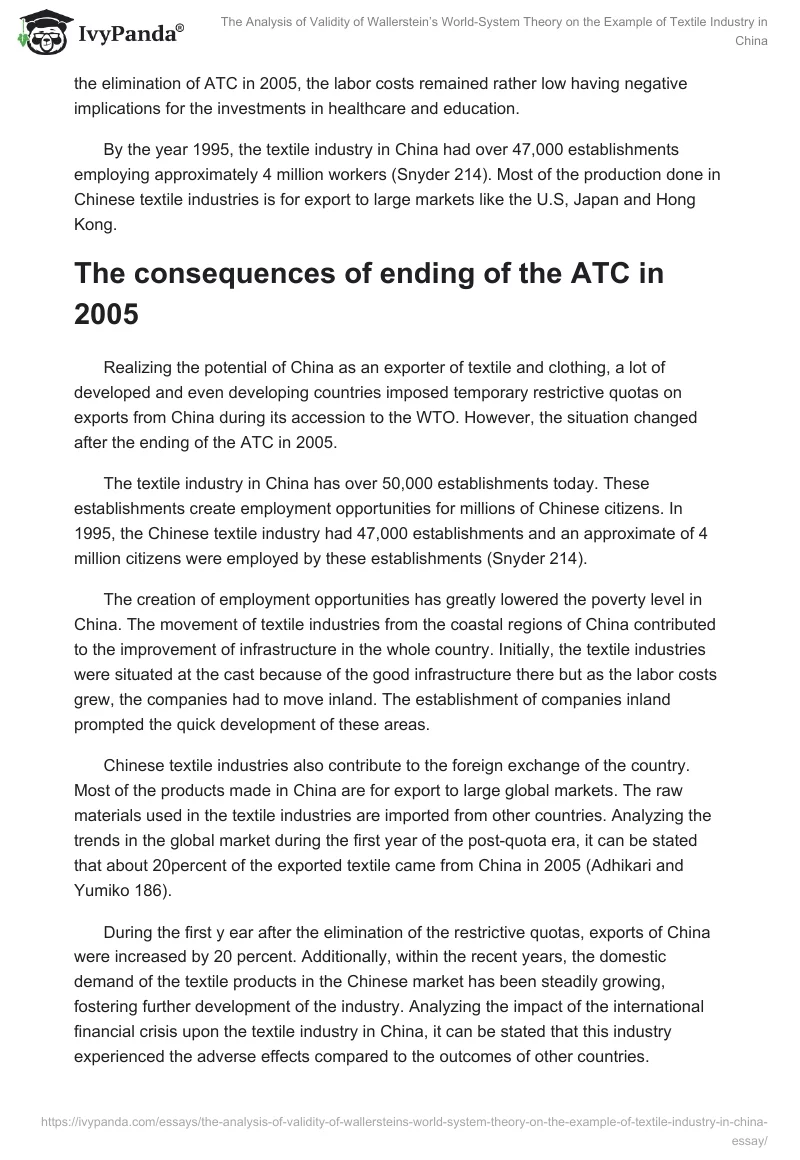Textile industry which is recognized as one of the most labor-intensive but requiring only minimal technologies has become one of the core industry sectors of China.
The potential of China as one of the world’s leading textile and clothing exporters was perceived as a hazard for the domestic markets by developed and developing countries which decided to impose quantitative quotas and restrict the import of Chinese textile. However, the situation was changed after the restrictive quotas were eliminated in 2005. This paper will analyze the latest tendencies in Chinese textile industry to test the validity of world-system theory offered by Wallerstein.
The impact of the textile industry on lives of Chinese people prior to 2005
The textile industry which is recognized as one of the most labor-intensive industries has been on the rise in China with its abundance of human resources within the recent decades. Until 2005, when the last quotas of the Agreement on Textiles and Clothing (ATC) were eliminated, the quantitative restrictions on the international exchange of textile and clothing was a significant hindrance for the realization of the full potential of China as one of the world’s leading exporters of textile and clothing.
Therefore, to preserve their comparative advantage and keep the prices low, the Chinese enterprisers had to use the human resources extensively to reduce the labor costs and consequently keep the prices on their products minimal. With the rapid tempos of development of the textile industry, a lot of human resources got involved into this industry sector from other traditional industries, including the agricultural sector.
Therefore, the development of the textile industry resulted in restructuring of the traditional industries of the country and influenced the traditional occupations of the population. However, due to the quantitative restrictions on international trade before the elimination of ATC in 2005, the labor costs remained rather low having negative implications for the investments in healthcare and education.
By the year 1995, the textile industry in China had over 47,000 establishments employing approximately 4 million workers (Snyder 214). Most of the production done in Chinese textile industries is for export to large markets like the U.S, Japan and Hong Kong.
The consequences of ending of the ATC in 2005
Realizing the potential of China as an exporter of textile and clothing, a lot of developed and even developing countries imposed temporary restrictive quotas on exports from China during its accession to the WTO. However, the situation changed after the ending of the ATC in 2005.
The textile industry in China has over 50,000 establishments today. These establishments create employment opportunities for millions of Chinese citizens. In 1995, the Chinese textile industry had 47,000 establishments and an approximate of 4 million citizens were employed by these establishments (Snyder 214).
The creation of employment opportunities has greatly lowered the poverty level in China. The movement of textile industries from the coastal regions of China contributed to the improvement of infrastructure in the whole country. Initially, the textile industries were situated at the cast because of the good infrastructure there but as the labor costs grew, the companies had to move inland. The establishment of companies inland prompted the quick development of these areas.
Chinese textile industries also contribute to the foreign exchange of the country. Most of the products made in China are for export to large global markets. The raw materials used in the textile industries are imported from other countries. Analyzing the trends in the global market during the first year of the post-quota era, it can be stated that about 20percent of the exported textile came from China in 2005 (Adhikari and Yumiko 186).
During the first y ear after the elimination of the restrictive quotas, exports of China were increased by 20 percent. Additionally, within the recent years, the domestic demand of the textile products in the Chinese market has been steadily growing, fostering further development of the industry. Analyzing the impact of the international financial crisis upon the textile industry in China, it can be stated that this industry experienced the adverse effects compared to the outcomes of other countries.
Since the year 2008, the export of the Chinese textile and the competitive advantages of the country in the global market were further enhanced. Moreover, due to the international financial crisis, Beijing decided to bypass the use of the US dollar for the international trade and use Yuan for international operations instead. During the fifth five-year plan (2006 – 2010), the textile and clothing industry in China have been restructured and upgraded.
Paying more attention to technological innovations, the Chinese enterprises improve their manufacturing operations and added value to their products. Additionally, more costs were spent on healthcare and education and healthcare expenses as compared to the previous years.
Thus, the labor costs were increased and the quality of the products improved, contributing to the competitive advantage of the Chinese textile and clothing products. Therefore, by raising the labor costs in the textile industry, the Chinese exporters can transfer from comparative advantage based on lower prices towards competitive advantage dependent upon quality of products and compliance with high standards.
Validity of Wallerstein’s world-system theory
Applied to the analysis of the recent tendencies in the Chinese textile industry, the world-system theory offered by Wallerstein can be helpful for understanding the relationships between nations, namely China and its export partners. However, Wallerstein’s premise concerning the principles of international division of labor between core, semi-periphery and periphery countries contradicts the recent trends in the industry under analysis.
On the one hand, the suggestion to view the social phenomena in complexity of economical and political factors instead of separating the data from different fields of studies is beneficial for better understanding of the processes taking place in the industry (Wallerstein 67).
On the other hand, the recent tendencies of the rapid growth of the textile industry in China and the rocketing rates of its international exports contradicts the main principle of dividing the labor between the countries depending upon the levels of their development.
Furthermore, the fact that China textile industry experienced the adverse effects from the international global crisis contradicts the premise that the world market is a complex unit. While the rest of the world suffered from the financial crisis, the rates of the Chinese textile exports were further enhanced.
Conclusion
Analyzing the main trends in development of the textile industry in China and its international exports in relation to the premises of the world-system theory offered by Wallerstein, it can be concluded that the phenomena of the real world partially contradict the assumptions of the social theory. At the same time, the world-system theory is helpful for understanding the relations between nations.
Works Cited
Adhikari, Ratnakar and Yumiko Yamamoto. “The Textile and Clothing Industry: Adjusting to the Post-Quota World”. Industrial Development for the 21st Century, 2007. Web.
Snyder, Rachel. Fugitive Denim: A moving Story of People and Pants in the Borderless World of Global Trade. New York: W.W. Norton & Company, 2008. Print.
Wallerstein, Immanuel. World-Systems Analysis: An Introduction. New York: Duke University Press. Print.


